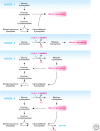NADPH-The Forgotten Reducing Equivalent
- PMID: 34074675
- PMCID: PMC8168431
- DOI: 10.1101/cshperspect.a040550
NADPH-The Forgotten Reducing Equivalent
Figures













References
-
- Berg JM, Tymoczko JL, Stryer L. 2012. Biochemistry, 7th ed. WH Freeman, New York.
Publication types
MeSH terms
Substances
LinkOut - more resources
Full Text Sources
Other Literature Sources
